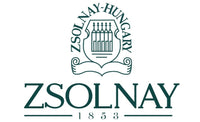
The Zsolnay Cultural Quarter
The city of Pécs lies between the South Transdanubian region of rolling hills and lush forests of Hungary. The Mediterranean-style city was awarded European Capital of Culture title in 2010, and, in fact, that city has preserved this status even today. Of the city`s countless attractions, Zsolnay Cultural Quarter, declared to be a Hungaricum (a unique Hungarian product or attraction) in 2014, undoubtedly stands out. Pécs is the hometown of the Zsolnay family, who founded the manufactory in 1853.
Today, the Zsolnay heritage lives on, thanks to the beautifully restored 5-hectare area of land that surrounds the manufactory. A total of 15 protected historic buildings and 88 public Zsolnay statues feature the scenic parks and promenades. The Zsolnay Cultural Quarter includes unique exhibitions that display the history of our manufactory. The Zsolnay Mausoleum, with 42 lions guarding the secret of eosin, can be visited in its original splendour as well.


Golden Age of Zsolnay - The Gyugyi Collection
The unique Zsolnay collection of more than 600 pieces by László Gyugyi, a Hungarian-born artist living in the United States, presents a stunning selection of ceramics from the Historicism and Art Nouveau periods.An engineer, László Gyugyi emigrated to the United States as a young man, where he built a career and began to indulge his passion for collecting decorative ceramics from the golden age of the Zsolnay Factory. At auctions in New York, London, Paris and Vienna, he acquired objects that had been auctioned off by clients and art collectors who were delighted by the success of the 1878 Paris World Exhibition. László Gyugyi bequeathed half of his collection of over 600 pieces to the city of Pécs as a gift.
The private Zsolnay collection of Dr. László Gyugyi comprising of around 600 pieces represents an unparalleled value. Its pieces date back to a 40-year period (1870-1910) that can be divided in three great parts: the periods of historicism, millennium and secession. The specialty of the collection is that it includes some signed and hand painted early pieces of the Zsolnay ladies; Teréz and Júlia.
The villa, which is now part of the private collection, was the residence of Julia Zsolnay and her husband, the architect Tade Sikorski, a Polish nobleman.

Pink Zsolnay Exhibition
The exhibition by the title „In the beginning was the pink” belongs to Barnabás Winkler, an architect, academic and doctor of arts who collected around one thousand Pink Zsolnay pieces. All pieces in this collection are unique: the handmade artefacts differ in their handles, their spout, their shape or in their glaze finish and colour. The exhibited objects of everyday use were produced in the Zsolnay Manufacture from the mid-19th century. Production was further developed with the help of a technique that was the result of the so-called pink-experiments started in the 1880’s.
Throughout the years the pink articles for everyday use had become popular objects for bathrooms, kitchens, dining rooms and studies alike. As the factory developed, the fully simple, plain shapes of the early stages have turned into more richly decorated – but still pink − pieces.
The simple vernacular style of pottery was often enriched with relieves, many times ornamented resembling a stucco, or the pieces were hand painted after burning, thus making them more unique.

